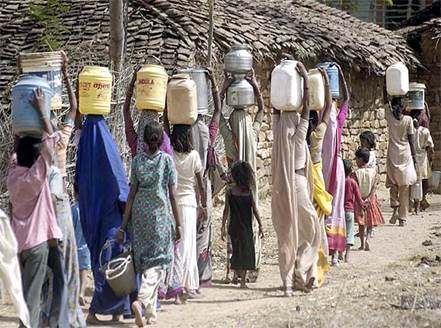Groundwater Augmentation:
A Key to
Safe Water
I
n many areas of our country ground water, which is the source for more than 85 percent of India’s rural domestic water requirements, 50 percent of its urban water requirements and more than 50 percent of its irrigation requirements is depleting fast due to its large scale withdrawal. There have been continued efforts in India for development of ground water resources to meet the increasing demands of water supply, especially in the last few decades. In certain high demand areas, ground water development has already reached a critical stage, resulting in declining ground water levels, shortage in water supply, intrusion of saline water in coastal areas and increased pumping lifts necessitating deepening of ground water structures. Geogenic contamination of ground water due to concentration of Arsenic, Fluoride and Iron in excess of the limits prescribed for drinking purposes (BIS, 2004) has also been observed in many parts of the country. To tackle the twin hazards of de-saturation of aquifer zones and consequent deterioration of ground water quality, there is an urgent need to augment the ground water resources through suitable management interventions. Water conservation implies improving the availability of water through augmentation by means of storage of water in surface reservoirs and tanks. It emphasises the need to modify the space and time availability of water to meet the demands. This concept also highlights the need for a judicious use of water.
Artificial recharge has now been accepted world-wide as a cost-effective method to augment ground water resources in areas where continued overexploitation without due regard to recharging has resulted in various undesirable environmental consequences. Diluting pollutant concentration through ground water recharge can be one of the effective ways to mitigate the hazards of high concentration of these contaminants. The process of supplementing may be either planned as storing water in pits, tanks etc. for feeding the aquifer or can be unplanned and incidental to human activities such as irrigation, leakages from pipes etc.
Artificial recharge aims at augmenting the natural replenishment of ground water storage by suitable civil construction techniques, spreading of water or artificially changing the prevailing natural conditions, the techniques depending on the hydro-geological situation in the area concerned. It helps in reducing overdraft, conserving surface run-off and increasing available ground water supplies because natural replenishment is a slow process, often unable to keep pace with the excessive and continued exploitation of ground water resources. This has resulted in declining ground water levels and depletion of ground water resources. For these reasons artificial recharge is becoming increasingly necessary to ensure sustainable groundwater reservoir.
1 Managed Artificial Recharge (MAR) by check dams helps to increase percolation for ground water recharge. It is achieved by harvesting the surface runoff through increasing the contact time between the water and the river bed to facilitate infiltration. This improves the groundwater recharge and reduces the runoff into the sea. Groundwater quality is also expected to improve as long as the impounded water is safeguarded from contamination. qArundhati Das
adas@devalt.org
1 Manual on artificial recharge of groundwater, Central Ground Water Board, Ministry of Water Resources